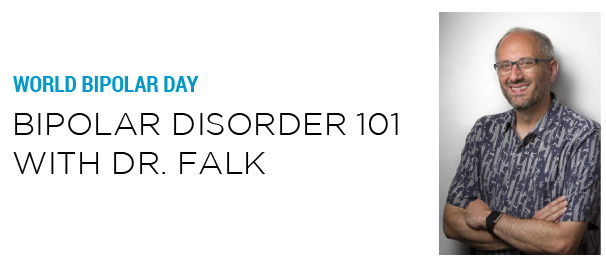March 30, 2021
World Bipolar Day: Bipolar Disorder 101 with Dr. Falk
Today, March 30th is World Bipolar Day, as promoted by the International Society for Bipolar Disorders and the International Bipolar Foundation. Dr. Neil Falk, Cascadia’s Interim Chief Medical Officer and Associate Medical Director, who provides Diagnosis Training, has given us a quick introduction.
Prevalence
Bipolar Disorder is often simultaneously over-diagnosed and under-diagnosed. Given the difficulty in accurately diagnosing Bipolar Disorder, it is hard to be certain how common it truly is. Estimates vary between 2% and 8% of the US population having Bipolar Disorder. Women tend to be diagnosed with Bipolar Disorder more often than men, although this may relate to women seeking treatment for mood episodes more often than men tend to.
Subtypes & Major Mood Episodes
Bipolar Disorder has three major subtypes, called Bipolar I Disorder, Bipolar II Disorder, and cyclothymia, according to the Diagnostic and Statistical Manual of Mental Disorders, 5th Edition (DSM 5). To understand these subtypes, let’s first discuss major mood episodes. Major mood episodes come in three types:
- Major depressive episodes last weeks to months, and include symptoms of severe depression such as depressed mood, anhedonia (loss of interest/ pleasure), appetite/weight changes, increased/decreased sleep, low energy, difficulty concentrating, physical slowing, feelings of worthlessness, and/or suicidal thoughts.
- Manic episodes last up to a few weeks, and include symptoms of abnormally elevated/ irritable mood such as increased energy/activity, decreased need for sleep, grossly inflated sense of worth, increased amount and rate of speech, disorganized/racing thoughts, easily distractibility, and increased impulsivity.
- Hypomanic episodes are similar to manic episodes but less intense. They last a few days to a few weeks and cause less disruption to the person’s everyday life. However, they represent a clear change from the person’s usual demeanor and activity level.
People with Bipolar Disorder have little to no symptoms 50-75% of the time, and often go months or years without symptoms. In fact, 10-20% of people considered to have “rapid cycling” Bipolar Disorder only have four or more major mood episodes in a year. However, people with Bipolar Disorder can develop a major mood episode at any time, often during times of stress or poor sleep.
- Bipolar I Disorder: About 60% of the time when people with Bipolar I Disorder have symptoms, they experience a major depressive episode. The remaining 40% of the time when people with Bipolar I Disorder have episodes, they experience either manic or hypomanic symptoms.
- Bipolar II Disorder: People with Bipolar II Disorder often have more frequent major mood episodes than people with Bipolar I Disorder. However, the major difference is that people with Bipolar II Disorder may have episodes of major depression or hypomania, but never mania.
- Cyclothymia:People with cyclothymia experience major mood symptoms even more frequently than those with Bipolar I and Bipolar II Disorders. However, these symptoms are either not intense enough or long enough in duration to be considered discrete mood episodes. In other words, people with cyclothymia have a lot of intense mood swings, but not major mood episodes.
Confusing things, people with Bipolar Disorder can also have major mood episodes of depression and mania (or hypomania) at the same time. These are often called “episodes with mixed features,” and the symptoms often appear similar to episodes of anxious depression. In addition, people can experience psychotic symptoms in episodes of severe depression or severe mania (but not hypomania).
Furthermore, over 50% of people with Bipolar Disorder have substance use issues, which can influence their moods as well as decrease the effectiveness of treatment. When adding in the stigma associated with mental health diagnoses, it is no wonder it averages almost eight years after the first major mood episode for someone with Bipolar Disorder to receive an accurate diagnosis.
Treatment
Thankfully, Bipolar Disorder is very treatable. The bedrock of treating Bipolar Disorder is social rhythm therapy, who involves the person creating a daily routine of activities and sleep. Establishing these biological and social rhythms helps create a stable emotional rhythm as well. Medications such as Lithium, valproic acid (Depakote), and lamotrigine (Lamictal) are often helpful as well. However, as antidepressants can cause mania in people who have Bipolar Disorder, their use for major depressive episodes for someone with Bipolar Disorder is controversial. Psychotherapy can also be helpful, not only in helping people recognize and manage their mood symptoms when they occur but also in establishing a healthy lifestyle that minimizes the chance of mood symptoms developing.

